Spithead and Nore mutinies
Sailors on 16 ships in the Channel Fleet, commanded by Admiral Lord Bridport, protested against the living conditions aboard Royal Navy vessels and demanded a pay rise, better victualling, increased shore leave, and compensation for sickness and injury.Finally, the new wartime quota system meant that crews had many landsmen from inshore (including some convicted criminals sent in lieu of punishment) who did not mix well with the career seamen, leading to discontented ships' companies.[6] When the situation calmed, Admiral Lord Howe intervened to negotiate an agreement that issued a royal pardon for all crews, reassignment of some of the unpopular officers, and a pay raise and abolition of the purser's pound.Inspired by the example of their comrades at Spithead, the sailors at the Nore, an anchorage in the Thames Estuary, also mutinied, on 12 May 1797, when the crew of Sandwich seized control of the ship.[8] Parker was a former master's mate who was disrated and court-martialled in December 1793 and re-enlisted in the Navy as a seaman in early 1797, where he came to serve aboard the brig-sloop Hound.Captain Sir Erasmus Gower commissioned HMS Neptune (98 guns) in the upper Thames and put together a flotilla of fifty loyal ships to prevent the mutineers moving on the city of London.Meanwhile, Captain Charles Cunningham of HMS Clyde, which was there for a refit, persuaded his crew to return to duty and slipped off to Sheerness.In Ireland there was talk of seizing British warships as part of a general insurrection, but it was only after the Spithead and Nore mutinies that United Irishmen awoke to "surprising effectiveness" of formulating sedition within the Royal Navy".As noted above, in July 1798 a court martial on HMS Defiance, took the evidence of the oaths of allegiance to the United Irishmen as a prelude to mutiny, and eleven men were sentenced to hang for it.[30] Recent attempts have been made to class these approaches under a heading of masculine identity, arguing that interpretations of what it meant to be a man for sailors marked the difference of motivation between the two mutinies.



mutiniesRoyal Navyradicalism in the Atlantic Worldstrike actionBritainwar with Revolutionary FranceLondon Corresponding SocietyUnited IrishmenIsle of WightSpitheadanchoragePortsmouthChannel FleetLord BridportPlymouthSeven Years' WarcopperingImpressmentquota systemAdmiraltypursertrue poundfloggingLord HoweThe Newgate CalendarThames EstuarySandwichRichard Parkermaster's matebrig-sloopCharles BucknerArticles of WarErasmus GowerHMS NeptuneblockadedJohn Borlase WarrenHMS GalateaRichard Goodwin KeatsvictuallingThamesCharles CunninghamHMS ClydeSheernesstreasonpiracyhangedyardarmfloggedtransportationWilliam Redferndog watchDeath maskHunterian Museum (London)Edmund BurkeBelfastNorthern StarHMS DefianceUnited Irish oathsIrish rebellion in the early summer of 1798HermioneWest IndiesLa GuairaMarie AntoinetteCape of Good HopeJervisDouglas JerroldThomas Cobham (actor)Frederick MarryatHerman MelvilleBilly BuddBenjamin BrittenBonamy DobréeBBC Radio 4Saturday Night TheatreH.M.S. DefiantRamage and the FreebootersDudley PopeThe Men They Couldn't HangFletcher ChristianDewey LambdinAlan LewrieJulian StockwinColumbia EncyclopediaDugan, JamesG. P. Putnam's SonsSchneer, Jonathan